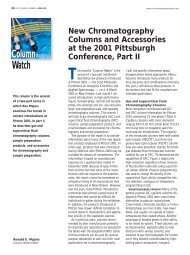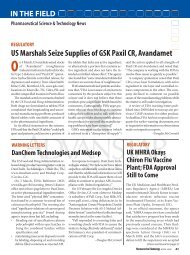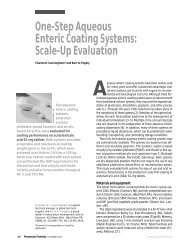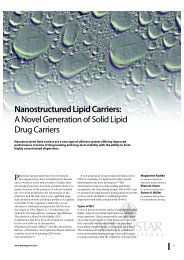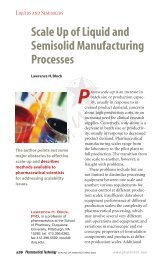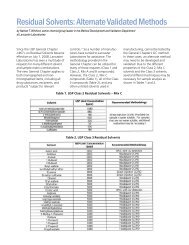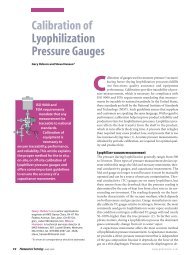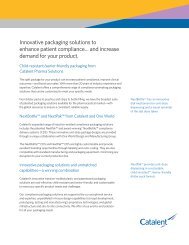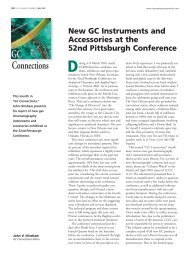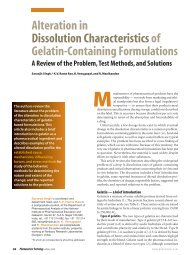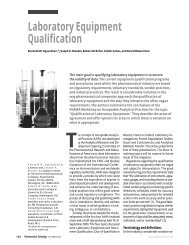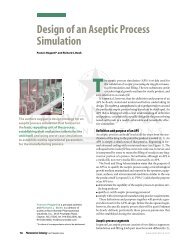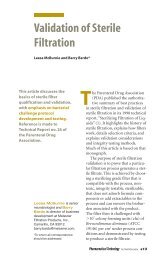Miconazole NitrateâLoaded Topical Liposomes - Pharmaceutical ...
Miconazole NitrateâLoaded Topical Liposomes - Pharmaceutical ...
Miconazole NitrateâLoaded Topical Liposomes - Pharmaceutical ...
Create successful ePaper yourself
Turn your PDF publications into a flip-book with our unique Google optimized e-Paper software.
Preparation and In Vitro Evaluation of<br />
<strong>Miconazole</strong> Nitrate–Loaded<br />
<strong>Topical</strong> <strong>Liposomes</strong><br />
R. Agarwal and O.P. Katare*<br />
<strong>Miconazole</strong><br />
nitrate is a widely<br />
used antifungal<br />
agent, but its use<br />
in topical<br />
formulations is<br />
not efficacious<br />
because deepseated<br />
fungal infections are difficult to treat<br />
with conventional topical formulations. The<br />
entrapment of a drug in liposomes can<br />
facilitate localized delivery of the drug, and<br />
improved availability by means of a<br />
controlled-release pattern can advance the<br />
treatment of deep fungal infections. This<br />
study examined critical parameters such as<br />
lipid composition, type of lipid, and charge,<br />
and the prepared products were<br />
characterized for liposome-specific<br />
properties such as microscopic appearance,<br />
size, and degree of drug entrapment.<br />
Significant retention of miconazole in skin<br />
was observed with the use of liposomes.<br />
IMAGE 100<br />
R. Agarwal is a senior research fellow and<br />
O.P. Katare is a reader in pharmaceutics<br />
at the University Institute of <strong>Pharmaceutical</strong><br />
Sciences, Panjab University, Chandigarh,<br />
India 160 014, tel 91 172 534112, fax 91 172<br />
541142, drkatare@yahoo.com.<br />
*To whom all correspondence should be addressed.<br />
<strong>Miconazole</strong> nitrate (MCZ) is a broad-spectrum antifungal<br />
agent of the imidazole group (1). It acts by<br />
means of a combination of two mechanisms: ergosterol<br />
biosynthesis inhibition, which causes lysis of<br />
fungal cell membranes because of the changes in both membrane<br />
integrity and fluidity, and direct membrane damage of the fungal<br />
cells. The drug is primarily used as a topical treatment for cutaneous<br />
mycoses (2); poor dissolution and lack of absorption<br />
make it a poor candidate for oral administration. However, MCZ<br />
can be used as a systemic antifungal agent when amphotericin B<br />
or ketoconazole is either ineffective or contraindicated.<br />
MCZ’s poor skin-penetration capability presents a problem<br />
in the treatment of cutaneous diseases by topical application.<br />
For effective treatment, the drug must be delivered in sufficient<br />
concentration to the site of infection (3). Various approaches<br />
have been used to enhance the access of such poorly<br />
skin-partitioned drug molecules. For example, the use of complexation<br />
with cyclodextrins has been reported to improve oral<br />
and topical delivery of MCZ (4,5). Other approaches have used<br />
submicron emulsions of MCZ for improved topical delivery<br />
(6,7) and chewing gum containing MCZ for buccal delivery<br />
(8,9). Several reports have described the potential use of liposomes<br />
to topically deliver drugs into the deep layers of the skin.<br />
The authors examined the use of closed lamellar vesicles<br />
whose unique structural and functional features facilitate the<br />
delivery of dermal drugs because they are biodegradable, nontoxic,<br />
amphiphilic in nature, penetration enhancing, and effective<br />
for modulating drug-release properties. These smectic<br />
mesophasic structures can be modified in terms of their size,<br />
shape, lamellae nature, and the type of composition used. The<br />
successful launch of the antifungal agent econazole (Pevaryl,<br />
CILAG, AG, Switzerland) on the market encouraged further exploration<br />
and exploitation of these molecules to make them<br />
more effective (10).<br />
Various studies have assessed the individual characteristics<br />
of MCZ, including degree of entrapment, size profile, drugrelease<br />
profile, and ability to carry the drug across the skin barrier.<br />
The analysis of MCZ in liposomes was determined using<br />
second-order derivative spectrophotometry (a simple spectrophotometric<br />
technique is not sensitive enough to produce accurate<br />
results for estimating a low amount of drug) (11,12).<br />
48 <strong>Pharmaceutical</strong> Technology NOVEMBER 2002 www.pharmtech.com
Table I: Effect of lipid composition on encapsulation<br />
efficiency of miconazole in liposomes using PCS.<br />
Composition Entrapment<br />
Ratio by Weight Efficiency (mg) Total Lipid<br />
Batch No. (MCZ:PCS:CHOL) Mean SD (mg)<br />
PLH 1 10:100:5 8.45 0.05 115<br />
PLH 2 10:100:10 8.79 0.04 120<br />
PLH 3 10:100:15 9.40 0.10 125<br />
PLH 4 10:100:20 9.76 0.04 130<br />
PLH 5 10:100:30 8.99 0.04 140<br />
PLH 6 10:100:50 8.88 0.03 160<br />
PLH 7 10:100:60 7.62 0.02 170<br />
PLH 8 10:100:70 8.32 0.02 180<br />
PLH 9 10:100:80 7.96 0.04 190<br />
Table II: Effect of lipid composition on encapsulation<br />
efficiency of miconazole in liposomes using PCU.<br />
Composition Entrapment<br />
Ratio by Weight Efficiency (mg) Total Lipid<br />
Batch No. (MCZ:PCU:CHOL) Mean SD (mg)<br />
PLG 1 10:100:5 8.58 0.10 115<br />
PLG 2 10:100:10 7.55 0.15 120<br />
PLG 3 10:100:15 7.20 0.17 125<br />
PLG 4 10:125:5 8.77 0.19 140<br />
PLG 5 10:125:10 8.58 0.12 145<br />
PLG 6 10:125:15 8.56 0.18 150<br />
PLG 7 10:150:5 9.40 0.21 165<br />
PLG 8 10:150:10 8.91 0.18 170<br />
PLG 9 10:150:15 8.74 0.15 175<br />
Experiment<br />
Materials. The materials used in the study were MCZ (Glaxo<br />
Ltd., Mumbai, India), Phospholipon 90H phosphatidyl choline<br />
saturated, (Nattermann Phospholipids, Cologne, Germany),<br />
phosphatidyl choline 97.3% content (PCS) (Nattermann), Phospholipon<br />
90G (unsaturated phosphatidyl choline) (Nattermann),<br />
phosphatidyl choline 98.0% content (PCU), (Nattermann),<br />
Sephadex G-50 medium cholesterol (CHOL) (Sigma,<br />
St. Louis, MO), dicetyl phosphate (DCP) (Sigma), and butylated<br />
hydroxy toluene (BHT) (Sigma).<br />
Preparation of liposomes. Multilamellar liposomes were prepared<br />
using the thin-film hydration method. Accurately weighed<br />
quantities of drug, PCS, PCU, CHOL, and DCP in the ratios<br />
shown in Table I and Table II were dissolved in chloroform in<br />
250-mL round-bottom flasks. A constant amount of BHT, equivalent<br />
to 2% of total lipid volume, was added as an antioxidant to<br />
the organic phase in the flasks. The chloroform was evaporated<br />
at 45 C under reduced pressure at 150 rpm using a Rotavapor<br />
film evaporator (Büchi RE 121, Flawil, Switzerland). After the<br />
chloroform was completly evaporated, the flasks were kept<br />
overnight under vacuum pressure to remove residual solvent.<br />
The thin film was hydrated using pH 6.4 phosphate-buffered<br />
saline (PBS) for 2 h until vesiculation was complete.<br />
Determination of drug entrapment in vesicles. Unentrapped, free<br />
drug was separated using the minicolumn centrifugation<br />
method (13). The 0.2-mL vesicular suspensions were first presaturated<br />
with empty vesicles and then placed in the column.<br />
Centrifugation was conducted at 2000 rpm for 3 min, and elutes<br />
containing drug-loaded vesicles were collected and observed<br />
under a light microscope for drug particles. The vesicular suspensions<br />
were analyzed using a spectrophotometer (Lambda<br />
15, PerkinElmer, Shelton, CT) and the second-order derivative<br />
technique.<br />
Analysis by second-order spectrophotometry. For this analysis,<br />
0.2-mL liposomal elutes were added to 10 mL of methanol and<br />
vortexed for 10 min for the extraction. The solutions thus obtained<br />
were centrifuged at 3000 rpm for 15 min to settle undissolved<br />
lipid in methanol. The supernatants were decanted and<br />
analyzed at 2 D 276.8<br />
using the spectrophotometer.<br />
Instrument. A PerkinElmer Lambda 15 recording doublebeam<br />
UV–vis spectrophotometer was used. The scan speed was<br />
120 nm/min. The auto mode of slit width ( 3) in the instrument<br />
smoothes the spectra without removing substantial<br />
peaks. The other parameters were slit 2 nm, response 0.5 s, and<br />
peak threshold 0.2 D2.<br />
Microscopy. All the batches were viewed under an optical microscope<br />
to determine the shape and lamellarity of vesicles. The liposomes’<br />
vesicle sizes were determined by light scattering on the<br />
basis of laser diffraction using the Malvern Mastersizer (model<br />
S, version 2.15, Worcestershire, Malvern, UK).<br />
Drug-leakage study from vesicles. The optimized liposomal<br />
batches (PLH 4, PLG 7) were sealed in 30-mL vials after purging<br />
with nitrogen and stored at various temperatures (4–8, 25 2,<br />
37, and 45 C) for a period of two months. Samples from each<br />
batch at each temperature were withdrawn at defined time intervals,<br />
and the residual amount of drug in the vesicles (i.e., entrapment)<br />
was determined as described in the drug-entrapment<br />
section (see Figure 1).<br />
Solubility study. The solubility of MCZ was determined using<br />
a thermostatic water-shaker bath at 37 C for 24 h. The excess<br />
of drug was added to 10 mL of phosphate buffer saline with a<br />
pH 6.4 value. An increasing concentration of the surfactant<br />
Tween 20 was added to stoppered 25-mL volumetric flasks.<br />
After the samples were shaken for 24 h, they were filtered using<br />
0.45-m membrane filters and analyzed after appropriate dilution<br />
using the spectrophotometer at 272 nm. These studies<br />
were conducted to determine the sink conditions for in vitro<br />
performance evaluation of the described systems.<br />
In vitro drug release study. Drug release studies included<br />
dialysis-membrane and skin-permeation trials on the hairless<br />
abdominal skin of LACA mice using modified Franz diffusion<br />
cells. Various formulations of liposomal (i.e., PLH 4 and PLG 7)<br />
and conventional creams with MCZ, each equivalent to 5 mg of<br />
drug, were applied to the membrane and skin facing the donor<br />
chamber. The receptor phase was 150 mL PBS with a pH 6.4<br />
value and 2% w/v Tween 20. An aliquot of 5 mL of sample was<br />
withdrawn from each batch and replaced with the same amount<br />
of buffer to maintain the receptor phase at 150 mL. The samples<br />
were quantitiated by UV spectrophotometer at 272 nm.<br />
Skin-retention studies. After conducting the permeation study,<br />
the authors carefully removed the skin mounted on the Franz<br />
diffusion cells. The remaining formulation adhering to the skin<br />
was scraped with a spatula and then wiped with tissue paper.<br />
50 <strong>Pharmaceutical</strong> Technology NOVEMBER 2002 www.pharmtech.com
Table III: Effect of DCP on entrapment<br />
efficiency of liposomal batches (PLH 4 and PLG 7).<br />
MCZ:PCS: Entrapment Efficiency<br />
CHOL:DCP (mg)/Total Lipid (mg)<br />
PLH 4 10:100:20:5 8.76 0.04/130<br />
10:100:20:10 9.76 0.06/130<br />
10:100:20:15 9.70 0.09/130<br />
10:100:20:20 9.80 0.121/130<br />
PLG 7 10:150:5:5 8.80 0.12/ 165<br />
10:150:5:10 9.40 0.21/165<br />
10:150:5:15 9.50 0.08/165<br />
10:150:5:20 9.45 0.16/165<br />
The cleaned skin piece was mashed, and 10 mL of methanol<br />
was added to the meshed mass and mechanically shaken in a<br />
water shaker bath at 37 1 C for 24 h for the complete extraction<br />
of the drug. The filtrate was removed and analyzed<br />
using derivative spectrophotometry.<br />
Results and discussion<br />
Entrapment efficiency. Influence of process parameters. Vacuum pressure,<br />
hydrating medium, hydration time, flask rotation speed,<br />
and method of size reduction were optimized to prepare lipid<br />
vesicles of MCZ. PBS at pH 6.4 was the best hydrating medium,<br />
with good stability and entrapment of the drug. Adjusting the<br />
evaporator’s rotation to 150 rpm increased the surface area for<br />
evaporation and was sufficient to form thin, uniform, and completely<br />
dried film. The size of liposome prepared from PCS was<br />
found to be 6 2.5 m, and the size of liposomes prepared<br />
from PCU was found to be 4 1.5 m.<br />
Analytical method. Analysis was completed using derivative<br />
spectrometry, which is a technique for the enhancement of sensitivity<br />
and specificity in qualitative and quantitative analysis<br />
of various compounds, including pharmaceuticals. The fine<br />
structural features of this derivative method have been sharpened<br />
and emphasized to provide an improved resolution of<br />
overlapping and have been potentiated to give greater sensitivity<br />
(14,15). Amplitude at 1 D 284<br />
and 2 D 276.8<br />
has been reported<br />
specifically for MCZ (16).<br />
Methanol was used for the extraction of the drug rather than<br />
a chloroform and methanol mixture because methanol results<br />
in more conspicuous peaks during analysis compared with a<br />
chloroform and methanol mixture. The authors found that<br />
simple absorbance estimation made it difficult to determine<br />
the drug content in liposomal elute obtained from sephadex<br />
columns because the sensitivity of the simple spectrophotometric<br />
technique is very low (E 17). Previous studies have<br />
shown that imidazole rings containing antifungal drugs such<br />
as MCZ have a relatively low absorption in the UV range and<br />
are difficult to analyze in low concentrations (17). Similarly,<br />
the authors found that the concentration obtained from the<br />
liposomal elute of the column was very low, and further minor<br />
interference from lipids made the estimation of MCZ in liposomes<br />
difficult as well as error prone. The authors had developed<br />
a method that is sensitive enough to analyze the drug in<br />
liposomal elute from a sephadex column. They found that the<br />
2<br />
D 276.8<br />
method is sensitive and specific for the determination<br />
of MCZ without interference from the lipids used (E 273,<br />
R 2 0.998, Y 0.0273X).<br />
Influence of formulation component variables. Table I and Table II summarize<br />
the various lipid concentration and drug entrapment efficiencies<br />
of the liposomal systems. Table III shows the effect of<br />
DCP on entrapment efficiency. The inclusion of DCP as a negatively<br />
charged agent into the lipidic layers could impede the aggregation<br />
and fusion of vesicles so as to maintain their integrity<br />
and uniformity. In addition, the antioxidant BHT (2% of total<br />
lipids) was added to each formulation to minimize the oxidative<br />
degradation of phospholipids that leads to stability problems.<br />
Table I lists the liposomes prepared with PCS. An increase<br />
in CHOL concentration with the same MCZ and PCS concentration<br />
(PLH 1 to PLH 4) led to an increase in entrapment levels<br />
of MCZ from 8.45 mg/115 mg to 9.76 mg/130 mg of total<br />
lipids. The increase in entrapment efficiency was attributed to<br />
the ability of CHOL to cement the leaking space in the bilayer<br />
membranes, which in turn leads to an enhanced drug level in<br />
liposomes (18). A further increase in CHOL level from 30 to<br />
80 mg (PLH 5 to PLH 9) with the phosphatidyl choline amount<br />
kept constant decreased the entrapment efficiency, although the<br />
total lipid level also was increased. This occurrence indicates that<br />
MCZ entrapment is enhanced up to a certain level of PCS and<br />
CHOL and substantiates the importance of the appropriate proportions<br />
of PCS and CHOL to maximize the entrapment affinity<br />
of drug toward bilayer-forming phospholipids.<br />
Table II lists the liposomes prepared with PCU. The authors<br />
found that increasing the PCU level increased the entrapment<br />
efficiency (PLG 1, PLG 4, and PLG 7). At the lower level of PCU<br />
at 100 mg (PLG 1), the entrapment efficiency was less. As the<br />
amount of PCU was increased to 150 mg (PLG 7) and CHOL<br />
was kept at a constant level of 5 mg, the entrapment efficiency<br />
increased to 9.4 mg per 165 mg of total lipids from 8.58 mg per<br />
115 mg of total lipids, respectively. Analogus to PCS liposomes,<br />
increasing the CHOL level while keeping the PCU level constant<br />
decreased the entrapment efficiency of MCZ. In contrast<br />
to PCS liposomes, the authors found that PCU-containing liposomes<br />
required a very low amount of CHOL (PCU:CHOL in a<br />
ratio of 150:5) to achieve maximum entrapment (PLG 7), and<br />
an increase in CHOL from 5 mg to 15 mg decreased the entrapment<br />
of MCZ to 8.74 0.15 per 175 mg of total lipids (PLG<br />
9). With PCS-containing liposomes, an increased amount of<br />
CHOL (PCS:CHOL ratio of 100:20) was required to achieve<br />
maximum entrapment.<br />
The entrapment efficiency data clearly suggest that the ratio<br />
of PCU to CHOL is crucial because an enhanced CHOL level<br />
disturbs entrapment, which also depends on the type of phosphatidyl<br />
choline used and the physicochemical nature of the<br />
drug. To study the effect of DCP level on both kinds of liposomes,<br />
varying amounts of DCP were added, and the degree of<br />
entrapment was determined. The addition of DCP considerably<br />
improved the liposomal formulation. Enhancing the amount<br />
from 5 to 10 mg helped raise drug loading from 8.76 to 9.45 mg,<br />
but beyond that range no appreciable change in entrapment was<br />
noted (see Table III). Furthermore, the improvement in the<br />
liposome-specific features (entrapment, vesicle uniformity, and<br />
stability) may be attributed to DCP’s ability to incorporate into<br />
lipid-layer domains imparting the polarity (negative charge).<br />
These properties facilitate the vesiculation process and pro-<br />
52 <strong>Pharmaceutical</strong> Technology NOVEMBER 2002 www.pharmtech.com
Figure 1: (a) The percentage of drug remaining in PLG 7 liposomes<br />
after subjecting them to temperatures of 4, 25, and 37 C for 15, 30,<br />
45, and 60 days. (b) The percentage of drug remaining in PLH 4<br />
liposomes after subjecting them to temperatures of 4, 25, 37, and<br />
45 C for 15, 30, 45, and 60 days.<br />
nounced uniformity in size distribution because the desired<br />
polar and nonpolar interactions are reached.<br />
Drug-leakage studies. The authors conducted a two-month<br />
study of liposomal stability with respect to the liposomes’ ability<br />
to retain an entrapped drug during a defined time period.<br />
The PLG 7 batch of liposomes was withdrawn from the study<br />
at 45 C after 2 weeks and at 37 C after 4 weeks because storage<br />
at these temperatures led to a substantial loss ( 90%) of<br />
drug from the liposomes by the end of a one-month period (see<br />
Figure 1a). Drug leakage at elevated temperatures may be a result<br />
of chemical degradation (oxidation and hydrolysis) of lipids<br />
in the bilayers, leading to defects in membrane packing. Thus,<br />
earlier reports of the low-temperature stability of liposomal<br />
products may be attributed to the deformation of gel-state lipid<br />
membranes that help hold MCZ molecules in place. Figure 1b<br />
shows that the drug-retention capacity of liposome PLH 4 is<br />
higher than that of PLG 7 in all conditions. The better stability<br />
of liposomes PLH 4 compared with PLG 7 may be attributed to<br />
the high phase-transition temperature of PCS (56 C) relative<br />
to the low phase-transition temperature of PCU (28–30 C), the<br />
greater affinity of PCS toward the drug molecule, and the liposomes’<br />
greater structural integrity. Both PCU and PCS have<br />
shown fairly high retention of drug inside the vesicles at 4 C<br />
and 25 C for as long as two months ( 90%).<br />
In vitro drug-release studies. Diffusion medium. Although physiological<br />
saline was potentially the most appropriate receptor phase,<br />
the drug was poorly soluble in water. Thus, an appropriate<br />
medium was required that could provide sufficient solubility for<br />
the drug to maintain the required sink condition during permeation<br />
studies. The authors used varying concentrations of<br />
Tween 20 to solubilize the drug. They found that increasing the<br />
surfactant concentration improved the solubility. A medium<br />
with 2% w/v Tween 20 provided a 0.239-mg/mL solubility, which<br />
was sufficient for the permeation study. Five milligrams of MCZ<br />
was placed in the donor compartment, and 150 mL of receptor<br />
medium was used. This permeation medium had an approximate<br />
sevenfold capacity to solubilize the added amount of drug.<br />
Diffusion study. Figure 2 shows the release profile of various formulations<br />
and their release fluxes. The release-behavior studies<br />
of MCZ-loaded liposomes showed retarded transfer of drug<br />
molecules across the vesicular systems composed of PCS and<br />
PCU when compared with that of the plain drug solution. The<br />
flux values obtained with various formulations were 109.36<br />
g/cm 2 /h (MCZ), 76.43 g/cm 2 /h (PLH 4), 70.4 g/cm 2 /h<br />
(PLG 7), 50.56 g/cm 2 /h (cream A), 33.6 g/cm 2 /h (cream B),<br />
and 32.53 g/cm 2 /h (cream C) for solution, PCS liposomes,<br />
PCU liposomes, commercial cream A, commercial cream B,<br />
and conventional cream, respectively. Analysis of these results<br />
showed that the liposomal systems composed of PCS and PCU<br />
had formed a release barrier through their multilamellar layers.<br />
PCU lipids had a greater release-retarding effect than did<br />
PCS lipids. <strong>Liposomes</strong> composed of saturated lipids normally<br />
show improved results because of the low leakage property of<br />
bilayers with an improved packing of lipid molecules. One<br />
could conclude that the change in the behavior of the PCU<br />
vesicles with a high lipid content strengthened the lipid barrier<br />
effect. However, the conventional and commercial creams<br />
showed decreased values of release flux because of the drug<br />
being dispersed in an insoluble form in cream C. The remaining<br />
formulation design factors of commercial creams did not<br />
affect the release flux.<br />
Skin-permeation and skin-retention studies. Figures 3 and 4 show the<br />
various results obtained in the skin-permeation, permeationflux,<br />
and skin-retention studies. The PCS and PCU liposomal<br />
systems had permeation flux values of 54.43 g/cm 2 /h (PLH<br />
4) and 51.4 g/cm 2 /h (PLG 7). The nonliposomal systems permeated<br />
the drug at a flux value of 81.66 g/cm 2 /h (MCZ),<br />
29.5 g/cm 2 /h (cream A), 41.23 g/cm 2 /h (cream B), and<br />
28.73 g/cm 2 /h (cream C). In the skin-retention studies of the<br />
liposomal systems, the amounts of MCZ retained were 0.84 mg<br />
(PLH 4) and 0.72 mg (PLG 7) for liposomes composed of PCS<br />
54 <strong>Pharmaceutical</strong> Technology NOVEMBER 2002 www.pharmtech.com
Figure 2: (a) Plot between the amount of MCZ released per unit area<br />
and the time for the optimized batches of PLH 4 and PLG 7 liposomes<br />
and drug in a cream base (cream A: commercial gel; cream B:<br />
commercial gel; cream C: prepared cream base). (b) A comparison of<br />
the rate of flux of miconazole released from liposomal and cream<br />
formulations (cream A: commercial gel; cream B: commercial gel;<br />
cream C: prepared cream base).<br />
Figure 3: (a) Plot between the amount of MCZ permeated per unit area<br />
and the time for the optimized batches of PLH 4 and PLG 7 liposomes<br />
and drug in cream base (cream A: commercial gel; cream B:<br />
commercial gel; cream C: prepared cream base). (b) A comparison of<br />
the rate of flux of miconazole permeated from the liposomal and<br />
cream formulations (cream A: commercial gel; cream B: commercial<br />
gel; cream C: prepared cream base).<br />
and PCU, and in the nonliposomal studies the skin retention<br />
values were 0.09 mg (MCZ), 0.15 (cream A), 0.12 mg (cream<br />
B), and 0.25 mg (cream C).<br />
These results show the influence of vesicular systems and<br />
nonvesicular formulations on the penetration, retention, and<br />
permeation tendencies of the drug molecules in various conditions.<br />
The study data show that liposomal systems can make<br />
the drug molecules accessible within the skin layers. The high<br />
retention but reduced permeation of the drug in vesicular systems<br />
can be attributed to intrinsic liposome–skin interaction<br />
behavior. This conclusion compares favorably with an earlier<br />
study that showed that the drug associated with liposome bilayers<br />
within the liposomal compartments can be better routed<br />
into the skin (20). Other studies have shown that liposomal ambience<br />
may help modify the permeability characteristics of the<br />
stratum corneum, and the systems keep the drug molecules<br />
within the skin layers so that their skin-substantivity is high<br />
(21–27).<br />
When the authors analyzed the effect of the liposomes’ composition,<br />
they found that liposomes composed of PCS show<br />
higher retention than those composed of PCU; therefore, drug<br />
molecules in saturated phospholipid bilayers are better localized<br />
in skin. Retention and permeation of MCZ with the conventionally<br />
formulated cream was significantly low when compared<br />
with liposomal forms. The poor performance of the<br />
conventional cream may be ascribed to the dispersed state of<br />
the drug in an insoluble form, which impairs penetration of the<br />
outer skin barrier. The retention and permeation properties of<br />
commerical creams were shown to be lower than those of liposomal<br />
systems, and commercial cream A showed improved penetration<br />
when compared with the other two creams. The enhanced<br />
penetration of cream A may be attributed to its<br />
formulation design.<br />
Conclusion<br />
Entrapment of MCZ in liposomes was achieved after studying<br />
the effect of various process and formulation variables. The<br />
amount of drug loaded into these vesicles ranged from 7.2 mg<br />
per 125 mg to 9.76 mg per 130 mg of total lipid. These systems<br />
were found to have good size and stability characteristics and<br />
exhibited improved permeation properties. The in vitro permeation<br />
study indicated that MCZ in an exquisite amphiphillic<br />
56 <strong>Pharmaceutical</strong> Technology NOVEMBER 2002 www.pharmtech.com
Figure 4: Skin retention of miconazole from PLH 4 and PLG 7<br />
liposomal and cream formulations (cream A: commercial gel; cream B:<br />
commercial gel; cream C: prepared cream base).<br />
atmosphere of a closed lamellar system forms depots in skin<br />
layers, revealed the merits of developed MCZ-loaded liposomes,<br />
and justified their potential for strengthening the efficacy and<br />
safety of a drug. The results of the skin-retention studies showed<br />
fairly high MCZ retention with liposomes when compared with<br />
commercial creams of MCZ. The higher permeation of drug<br />
across the skin and greater retention in the skin with liposomal<br />
systems clearly show that liposomes can penetrate and form depots<br />
in skin layers. The liposomal phospholipids (natural constituent<br />
of skin lipids) proved better for generating and retaining<br />
the required physicochemical state of skin for enhanced<br />
permeation and retention. This characteristic can be attributed<br />
to phospholipids’ ability to vesiculate independently because<br />
they carry two bulky nonpolar lipid chains and a polar-head<br />
group, which helps them spontaneously form into closed bilayered<br />
systems and produce long-lasting effects.<br />
Acknowledgment<br />
The authors are thankful to Nattermann Phospholipids (Germany)<br />
for the generous supply of phospholipids and the Council<br />
of Scientific and Industrial Research (India) for providing<br />
financial assistance for the project.<br />
References<br />
1. J.E. Bennett,“Antimicrobial Agents: Antifungal Agents,” in The Pharmacological<br />
Basis of Therapeutics, J.G. Hardman, L.E. Limbird, and A.<br />
Goodman Gillman, Eds. (McGraw-Hill, New York, NY, 9th ed., 2001),<br />
pp. 1175–1190.<br />
2. T.A. Gossel,“<strong>Topical</strong> Antifungal Products,” U.S. Pharmacist 10 (June),<br />
44–46 (1985).<br />
3. S. Tenjarla et al., “Preparation, Characterization, and Evaluation of<br />
<strong>Miconazole</strong>–Cyclodextrin Complexes for Improved Oral and <strong>Topical</strong><br />
Delivery,” J. Pharm. Sci. 87 (April), 425–429 (1998).<br />
4. M. Pedersen et al., “Formation and Antimycotic Effect of Cyclodextrin<br />
Inclusion Complexes of Econazole and <strong>Miconazole</strong>,” Int. J. Pharm.<br />
90 (31 March), 247–254 (1993).<br />
5. M. Pedersen, “Isolation and Antimycotic Effect of a Genuine <strong>Miconazole</strong><br />
-Cyclodextrin Complex,” Eur. J. Pharm. Biopharm. 40 (1),<br />
19–23 (1994).<br />
6. M.P. Piemi et al.,“Positively and Negatively Charged Submicron Emulsions<br />
for Enhanced <strong>Topical</strong> Delivery of Antifungal Drugs,” J. Controlled<br />
Release 58 (29 March), 177–187 (1999).<br />
7. P. Wehrle, D. Korner, and S. Benita, “Sequential Statistical Optimiza-<br />
Circle/eINFO 78<br />
58 <strong>Pharmaceutical</strong> Technology NOVEMBER 2002 www.pharmtech.com
tion of a Positively Charged Submicron Emulsion of <strong>Miconazole</strong>,”<br />
Pharm. Dev. Technol. 1 (1), 97–111 (1996).<br />
8. M. Pedersen and M.R. Rassing, “<strong>Miconazole</strong> and <strong>Miconazole</strong> Nitrate<br />
Chewing Gum as Drug Delivery Systems: Practical Application of<br />
Solid-Dispersion Technique,” Drug Dev. Ind. Pharm. 16 (1), 55–74<br />
(1990).<br />
9. M. Pedersen and M.R. Rassing, “<strong>Miconazole</strong> Chewing Gum as a Drug<br />
Delivery System Test of Release-Promoting Additives,” Drug Dev. Ind.<br />
Pharm. 17 (3), 411–420 (1991).<br />
10. R. Naeff, “Feasibility of <strong>Topical</strong> Liposome Drugs Produced on an Industrial<br />
Scale,” Adv. Drug Del. Rev. 18, 343–347 (1996).<br />
11. V. Cavrini, A.M. Di Pietra, and M.A. Raggi, “Colorimetric Determination<br />
of <strong>Miconazole</strong> Nitrate in <strong>Pharmaceutical</strong> Preparations,” Pharm.<br />
Acta Helv. 56 (6), 163–165 (1981).<br />
12. K. Wrobel et al., “Determination of <strong>Miconazole</strong> in <strong>Pharmaceutical</strong><br />
Creams Using Internal Standard and Second-Derivative Spectrophotometry,”<br />
J. Pharm. Biomed. Anal. 20 (1–2), 99–105 (1999).<br />
13. R.R.C. New, <strong>Liposomes</strong>: A Practical Approach, (IRC, Oxford, England,<br />
1990).<br />
14. S. Altinoz and O.O. Dursun, “Determination of Nimesulide in <strong>Pharmaceutical</strong><br />
Dosage Forms by Second-Order Derivative UV Spectrophotometry,”<br />
J. Pharm. Biomed. Anal. 22, 175–182 (2000).<br />
15. F. Sanchez Rojas, C. Bosch Ojeda, and J.M. Cano Pavon, “Derivative<br />
Ultraviolet-Visible Region Absorption Spectrophotometry and its Analytical<br />
Applications,” J. Pharm. Biomed. Anal. 6, 54–61 (1988).<br />
16. D. Bonazzi et al.,“Determination of Imidazole Antimycotics in Creams<br />
by Supercritical Fluid Extraction and Derivative Spectroscopy,” J.<br />
Pharm. Biomed. Anal. 18, 235–240 (1998).<br />
17. P.Y. Khashaba et al., “Analysis of Some Antifungal Drugs by Spectrophotometric<br />
and Spectrofluorimetric Methods in Different <strong>Pharmaceutical</strong><br />
Dosage Forms,” J. Pharm. Biomed. Anal. 22, 363–376 (2000).<br />
18. J. Plessis et al., “The Influence of Lipid Composition and Lamelarity<br />
of <strong>Liposomes</strong> on the Physical Stability of <strong>Liposomes</strong> upon Storage,”<br />
Int. J. Pharm. 127, 273–278 (1996).<br />
19. V.B. Patel and A.N. Mishra, “Encapsulation and Stability of Clofazimine<br />
<strong>Liposomes</strong>,” J. Microencaps. 16 (3), 357–367 (1999).<br />
20. R. Agarwal, O.P. Katare, and S.P. Vyas, “Preparation and In Vitro Evaluation<br />
of Liposomal/Niosomal Delivery Systems for Antipsoriatic<br />
Drug Dithranol,” Int. J. Pharm. 228, 43–52 (2001).<br />
21. J. Fang et al., “Effect of <strong>Liposomes</strong> and Niosomes on Skin Permeation<br />
of Enoxacin.,” Int. J. Pharm. 219, 61–72 (2001).<br />
22. J. Du Plessis et al.,“The Influence of Particle Size of <strong>Liposomes</strong> on the<br />
Disposition of Drug into Skin,” Int. J. Pharm. 103, 277–282 (1994).<br />
23. M. Sentjurc, K. Vrhovnik, and J. Kristl, “<strong>Liposomes</strong> as a <strong>Topical</strong> Delivery<br />
System: The Role of Size on Transport Studied by the EPR Imaging<br />
Method,” J. Controlled Release 59, 87–97 (1999).<br />
24. K. Vrhovnik et al., “Influence of Liposome Bilayer Fluidity on the<br />
Transport of Encapsulated Substance into the Skin as Evaluated by<br />
EPR,” Pharm. Res. 15, 525–530 (1998).<br />
25. J. Lasch and J. Bouwstra, “Interaction of External Lipid (Lipid Vesicles)<br />
with the Skin,” J. Liposome Res. 5, 543–569 (1995).<br />
26. M. Mezei and V. Gulasekharam, “<strong>Liposomes</strong>: A Selective Drug Delivery<br />
System for the <strong>Topical</strong> Route of Administration in Lotion Dosage<br />
Form,” Life Sci. 26, 1473–1477 (1980).<br />
27. M. Mezei and V. Gulasekharam, “<strong>Liposomes</strong>: A Selective Drug Delivery<br />
System for the <strong>Topical</strong> Route of Administration: Gel Dosage Form,”<br />
J. Pharm. Pharmacol. 34, 473–474 (1982). PT<br />
Circle/eINFO 44<br />
60 <strong>Pharmaceutical</strong> Technology NOVEMBER 2002 www.pharmtech.com


